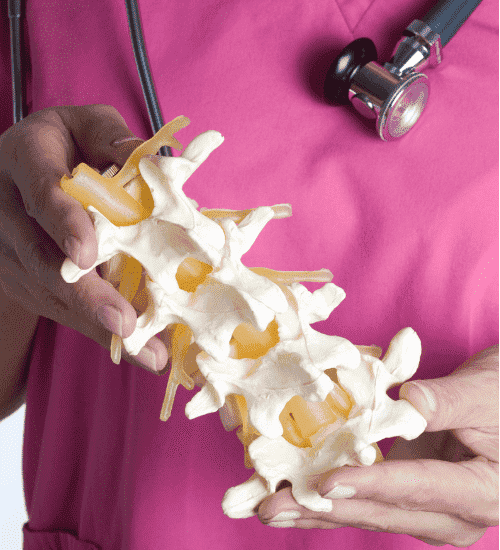- (213) 369-4583
- Monday - Friday
- 9 am - 5 pm
Spinal Cord Stimulator Treatment in Los Angeles

Dec 26, 2022
According to an estimate, roughly 20-40% of back surgeries in the US fail to relieve the patient of pain. Failed Back Syndrome is a condition where, for some reason, surgery could not treat the cause of the back pain. Now if you are someone who is facing a similar situation and you don’t want to go through the painful surgical procedure again, Spinal Cord Stimulation would be an effective treatment for you.
Book an appointment now with a spine surgeon in Los Angeles for Spinal Cord Stimulation treatment. You can call us at 213-369-4583 or fill out the contact form.
What is a Spinal Cord Stimulator?
A spinal cord stimulator (SCS) or dorsal column stimulator (DCS) is an implantable device that sends electrical signals to the spinal cord for the treatment of certain pain conditions. In simple terms, doctors use a spinal cord stimulator to treat chronic pain. They implant it in the body, usually in the lower back, and it sends electrical signals to the spinal cord. These signals interfere with the pain signals sent to the brain, which can help reduce the perception of pain. Spinal cord stimulators often treat chronic pain conditions like failed back syndrome, neuropathic pain, and chronic regional pain syndrome. They can be an effective treatment option for people who have not found relief from other pain management techniques, such as medication or physical therapy.
Who is a candidate for Spinal Cord Stimulation Treatment?

The primary objective of selecting patients for spinal cord stimulation is to ensure that they have the highest chance of benefiting from the treatment while minimizing the risks, complications and negative outcomes. The best way to achieve this goal is through a thorough assessment by a team of experts in various disciplines and a candid discussion with the patient about their expectations and objectives. This will help determine which patients are most suitable for spinal cord stimulation.
It is recommended for the following conditions:
- Chronic back pain from failed spinal fusion (non-union)
- Slow healing of fractured bones
- Complex regional pain syndrome (CRPS)
- Diabetes-related neuropathy (nerve damage)
- Arthritis (Or Spinal Arthritis)
Surgical procedure for implanting SCS
The spinal implant is a two-step surgical process:
1. Trial
Before the implantation procedure, doctors will place a temporary spinal cord stimulator on the skin during a trial period to see if it helps reduce the patient's pain. If the trial is successful, doctors will then schedule the patient for the implantation procedure.
2. Permanent Implant
If the results from the trial implant are promising, you will qualify for the permanent implant.
Procedure
The process for implanting a spinal cord stimulator typically involves the following steps:
- Anesthesia: Doctors typically perform the implantation procedure under local anesthesia and sedation, although they may use general anesthesia in some cases.
- Incision: The surgeon will make a small incision in the skin to access the area where they will implant the device.
- Implantation of electrodes: The surgeon will then implant the electrodes next to the spinal cord. Thin wire leads connect the electrodes to the generator, which the surgeon will implant in a separate location.
- Implantation of generator: Surgeons usually implant the generator, a small device that produces electrical signals, in the abdomen or buttocks.
- Closure: The incisions are closed with sutures or staples.
Surgeons typically complete the procedure, which usually takes several hours, on an outpatient basis. After the procedure, the patient will need to rest for a few days before returning to normal activities.
Benefits of using a Spinal Cord Stimulator

A spinal cord stimulator is usually considered when the body’s natural healing process is slow or doesn’t respond to other treatment options. Chronic pain can be debilitating and affects millions of people worldwide. Traditional treatments such as oral medication and surgery can be ineffective or have unwanted side effects. Spinal cord stimulation is a revolutionary, non-invasive treatment option that offers adjustable and targeted pain relief, with limited or no side effects. Below we have discussed the advantages of spinal cord stimulation and how it can be a game-changer in managing chronic pain:
1. Personalized Pain Management
Not all patients experience the same level of pain even if they suffer from the same disorder. Spinal cord stimulation offers a wide range of pain adjustment options on the hand-held controller, and some models adjust automatically to the person's movements. This gives patients the power to control their pain and experience a significant improvement in their quality of life.
2. Less Invasive
Spinal cord stimulation is a minimally invasive procedure that requires only one incision to implant the generator. Surgeons typically place the leads with electrodes using a hollow needle, rather than making an incision. This means patients experience less pain and recover faster, with fewer side effects and complications. If the stimulator doesn’t serve the purpose, it can easily be removed in the future.
3. Less dependence on Pain-killers
Spinal cord stimulation can significantly reduce the need for opioid medication. Studies show that more than a third of participants who received high-frequency therapy reduced or stopped taking opioid medications. This is a significant advantage for patients who have been dealing with chronic pain for many years.
4. Targeted Pain Relief
Spinal cord stimulation delivers pain relief only where it is needed, unlike oral medication which affects the whole body and causes sleepiness, constipation, or other problems unrelated to the pain. This targeted approach ensures that patients experience pain relief without unwanted side effects.
5. Affordable
Spinal cord stimulator is less costly when compared with other surgical and non-surgical treatments for back pain.
6. Long-lasting Pain Relief
One of the major benefits of a Spinal Cord Stimulator is that patients can enjoy a pain-free life for a long time without the need for any maintenance of frequent doctor visits.
Risks and Side effects associated with Spinal Cord Stimulation Treatment (SCS)
Doctors regard SCS as a secure, less invasive treatment for various painful disorders. However, they observe complications, which may fall into two categories: device-related failure or biological causes, in 30-40% of cases. Lead migration, lead breakage, excessive or insufficient stimulation, intermittent stimulation, hardware malfunction, loose connections, and battery failure, are all examples of device-related difficulties. Infection, epidural hemorrhage, seroma, paralysis, cerebrospinal fluid (CSF) leakage, discomfort at the implant site, allergic response, and skin disintegration are examples of biological consequences.
Such complications can lead to the following side effects:
- Infection - Almost all implants run the risk of causing infection in the body. In some cases, stimulators installed within the spine can cause infection creating the need for surgical treatment to cure the infection and remove the implant.
- Problems with Lead - The hardware of the lead sometimes gets displaced or broken due to movement in the spine. It happens when the movement of the vertebra doesn’t match the flexibility or movement of the spine.
- Decrease in the effectiveness of pain relief over time.

SCS Implant At Southern California Brain & Spine Surgery
If you are looking for Spinal Cord Stimulation treatment in Los Angeles, you can visit our facility. Dr. Moksha Ranasinghe who is the lead Neurosurgeon here provides spinal cord stimulation treatment to patients suffering from chronic back pain. You can schedule an appointment by filling out the contact form or calling us at (213) 369 4583.
FAQs on Spinal Cord Stimulation Treatment
1. What are the components of a Spinal Cord Stimulator System?
A spinal cord stimulation system is made up of several parts, including an implanted power source known as a neurostimulator, thin wires with electrodes on the tips called leads, a clinician programmer used to program the neurostimulator, a patient programmer for managing pain relief, and a wireless external neurostimulator that mimics the therapy delivered by the implanted neurostimulator.
2. Are all Spinal Cord Stimulators the same?
No. Mainly, there are three types of Spinal Cord Stimulators;
- Conventional implantable pulse generator, or IPG. A battery is placed in the spine during an operation. When it runs out, the battery must be replaced in another surgery. This can be a good choice for people with pain in just one body part because they need less energy to manage their pain.
- Rechargeable implantable pulse generator. A battery is placed in the spine during an operation. You can recharge it without another surgery. Because the energy source is rechargeable, these stimulators can put out more electricity. This may be a better choice for people with pain in the lower back or both legs. The device is more powerful than conventional IPGs.
- Radiofrequency stimulator. This type of Stimulator is an older design. It uses a battery that's outside the body. The stimulator is rarely used today because of newer designs and better technology. This includes rechargeable batteries. But like the rechargeable IPGs, these may be better for people with pain in the lower back and legs because of the device's power.
3. Are there any risks of spinal cord stimulator surgery?
Spinal cord therapy is a safe procedure, however, there can be some complications such as infection, device damage, etc. Consult your doctor immediately if there are any complications after the implant.
4. How does Spinal Cord Stimulator Work?
In spinal cord stimulators, doctors connect thin wires (the electrodes) to a small, pacemaker-like battery pack. A generator is usually placed under the skin, usually near the buttocks or abdomen, between the spinal cord and the vertebrae (the epidural space). The remote control and antenna of spinal cord stimulators are both outside the body, so patients can send electrical impulses whenever they feel pain. Experts have come to understand that the device is possibly working by targeting multiple muscle groups directly from the spine. Additionally, they've learned that this treatment can alter how the brain senses pain.




